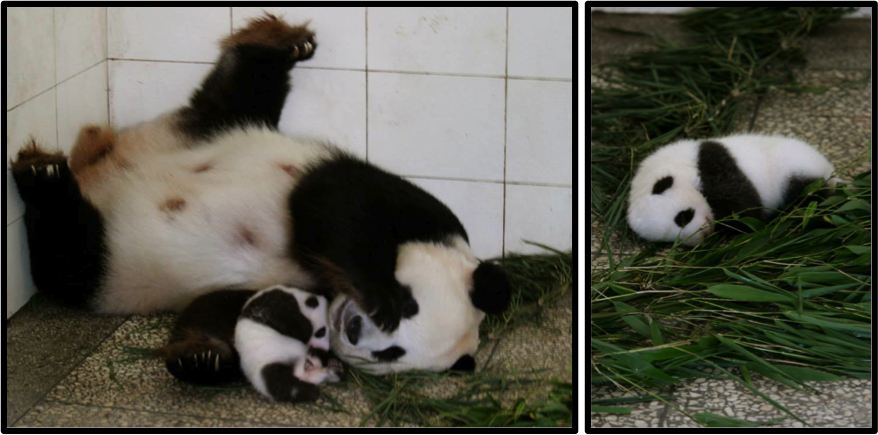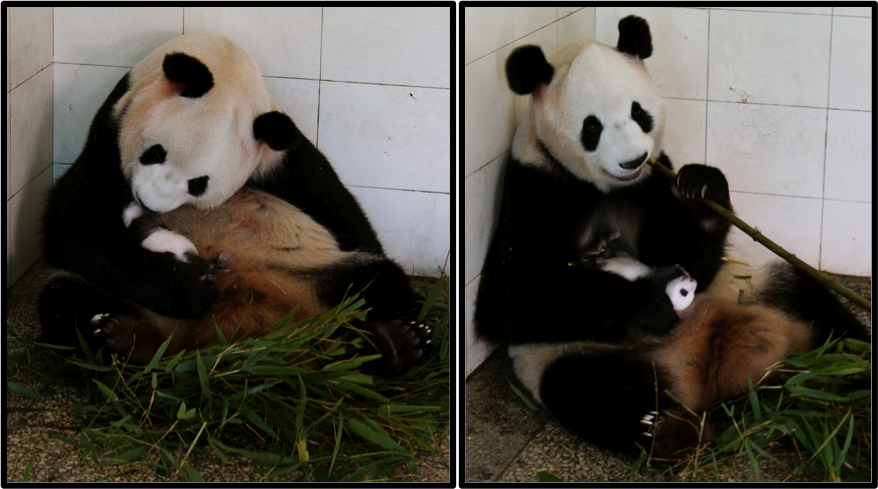I find the reproduction of the Giant Panda so unique and so fascinating. Throughout the short time I’ve spent at Bi Feng Xia I’ve learnt so much. I do believe practical experience is far greater than any knowledge gained from reading scientific articles. If you immerse yourself in the environment that they live and the world that they know, you begin to understand why such fascinating evolutionary adaptations take place. You also get to experience the exception to the rule. Not every panda is the same and therefore not every mating, artificial insemination, pregnancy, birth and maternal care will imitate each other.
The Giant Panda, unrelated to the Red Panda fun fact for all those who didn’t know, are carnivorous mammals[1]. The extreme depletion of their natural habitat and food source has forced them out of lowland areas and into high, bamboo-inundated mountains[2]. They have a conservation status of endangered[3], however recent efforts from scientist, ecologist, biologist, conservationists and anyone willing to help has bought about new knowledge of these allusive creatures. The captive breeding program has improved and the number of panda cubs that are born and survive in captivity is higher than ever. However, it’s still not enough to be increasing their population numbers. Much more work is still needed.
Pandas reach sexual maturity between the ages of four and eight and are reproductive until about age 20[2]. Their reproductive life span is increased in captivity as environmental conditions and food is much better compared to the wild. Females are only in estrus for 2-3 days each year[1] and will probably only have one cub every two years out in the wild. Gestation varies immensely in the Giant Panda, it can range anywhere between 95 to 160 days. This variation is due to delayed implantation, an adaptation that the Giant Panda has developed to cope with variability in food and environmental conditions. Delayed implantation is where a fertilized egg does not immediately implant on the uterine wall; instead the egg floats around in the reproductive tract for varying lengths of time[2]. Most births happen in the late summer to fall, as this is when the newest most protein-filled bamboo shoots are available. This is vital for cubs that are faced to grow up on such a nutrient poor diet.
Panda cubs are the smallest non-marsupial born mammals relative to their mother’s size[4]. The pink, blind and toothless infants are a mere 90-130g when born, roughly 1/800th of their mothers weight[5]. After one month of age the colour of their fur is fully developed. The cubs will stay with their mum for 18 months to two years out in the wild, however they are weaned at about four to five months of age in captivity.
Three pandas that are currently at Bi Feng Xia have very different reproductive stories. I’ve been lucky enough to study two of the three, but for reasons that will become apparent, I am unable to study the third. I would like to introduce you to Xi Xi, Ying Hua and Zhuang Mei.
Xi Xi, the eldest of the three at 14 years old. She came to Bi Feng Xia in 2008. Her baby was born on the 10th of August; this was not her first time having a cub. She looked after it from the very beginning and still does. Xi Xi’s bub is a lot bigger now, he has started crawling and Xi Xi has started playing with him. It’s a lot of fun to see the social side of these creatures.
Ying Hua is 10 years old and is currently taking care of her second baby. She was transported to Bi Feng Xia in late February this year from Beijing Zoo and will remain here to hopefully produce some more gorgeous babies. The first three days after Ying Hua gave birth she often forgot about her baby when sleeping. The keepers decided, for the safety of the infant, to take her baby to the kindergarten each night. After those initial three days Ying Hua was able to take care of her baby both day and night. Ying Hua’s baby is now just over a month old and has been with her mother ever since.
Zhuang Mei is the youngest of the three mothers. She was born at Bi Feng Xia in 2008. This new mother had twins who are a little over a month old now. However she does not take care of either. A female panda doesn’t always pick up the maternal instinct the first time around. Here in captivity the keepers will do their best to train her in maternal behaviours, but they can only do so much. Zhuang Mei probably won’t take care of either baby this time round. They are in good care in the kindergarten being hand-reared by the keepers. Zhuang Mei is just beginning her reproductive life and hopefully more babies will be bread by her and she will learn step by step how to be a good mother.
Reproduction in captive giant pandas has been notoriously difficult. Spending time at the base and being surrounding by the breeding program they have here is a real eye opener into what actually has to go into every mating, pregnancy, birth and maternal care. It makes me want to learn more about these animals. I guess it’s lucky I have another two months here!
-Grace
References:
[1] Swaisgood, R., Lindburg, D., and Zhang, H. (2002) iscrimination of oestrous status in giant pandas (Ailuropoda melanoleuca) via chemical cue in urine. Journal of Zoology 257, 381-386.
[2] McGeehan, L., Li, X., Jackintell, L., Huang, S., Wang, A., and Czekala, N. (2002) Hormal and behavioural correlates of estrus in captive giant pandas. Zoo Biology 21, 449-466.
[3] Lü, Z, Wang, D. & Garshelis, D.L. (IUCN SSC Bear Specialist Group) (2008) Ailuropoda melanoleuca. In: IUCN 2013. IUCN Red List of Threatened Species. Version 2013.1. <www.iucnredlist.org>. Downloaded on 12 September 2013.
[4] Smithsonian National Zoological Park (2012) Giant Panda. <nationalzoo.si.edu>. Downloaded on 12 September 2013.
[5] World Wildlife Fund (2013) Giant Panda. <http://worldwildlife.org/species/giant-panda>. Downloaded on 13 September 2013.




Just a note to let you know that Yi Ran is Shui Xiu’s first born daughter, born on July 24, 2012 at Bifengxia. So she is 14 months old, not 4 months old.
No need to post my comment.
Thanks Danielle!! I must have miss heard the keepers when they told me 🙂
Shui Xiu had another set of twins on the 12th of August and is currently taking care of one of them.
Thanks!
Beautiful story. Thank You for sharing
very cool! love your work panda cubs are born in late summer/ fall not spring, mating season is spring. just a typo, but you should know… it would make since if they were born in the spring, but nothing makes since in panda biology, they are a fluke in evolution!
keep up the great work. brad josephs
Thanks for catching that Brad! I’ve fixed the typo and hopefully you’ll be checking our other post 😉